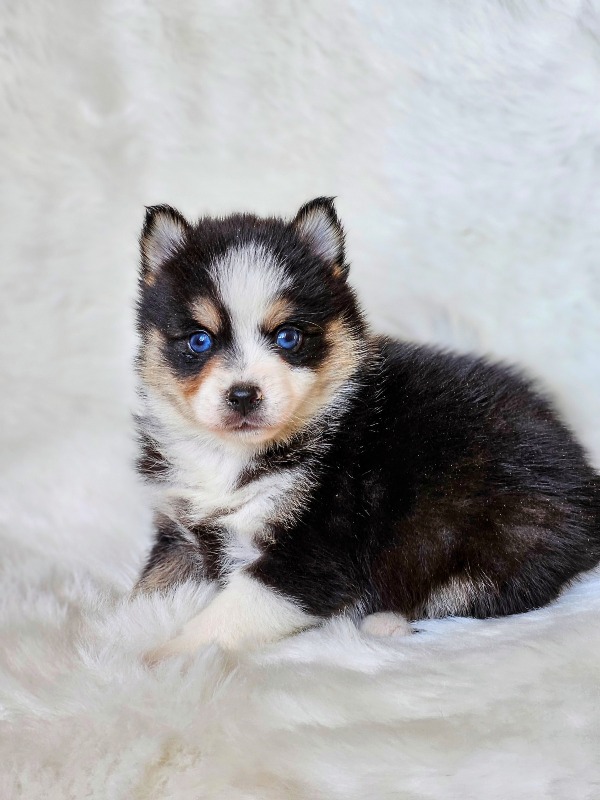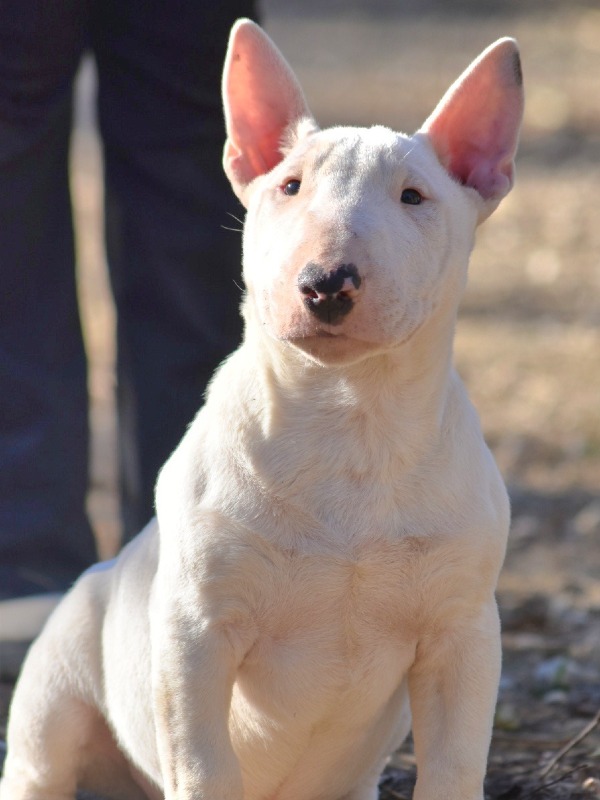Bull terrier miniature
Welcome to our page dedicated to the breed of dog bull terrier miniature!
Here, you will find all the useful information about bull terrier miniature. This descriptive profile will allow you to discover the aspects of this breed. You can notably consult information about the average price, monthly and annual upkeep expenses, their health, name ideas, as well as their official recognition by competent authorities.
Explore this page to discover everything you need to know.
Overall description of the breed
The Miniature Bull Terrier is an unusual breed, firstly because of its unique appearance and secondly because of its very special character which makes it a unique pet. The standard version is the result of several crosses between the English White Terrier and the English Bulldog, however the Dalmatian and the Staffordshire Bull Terrier have also been introduced in its conception by some breeders.
The miniature version is simply a recent selection work carried out by some breeders, they managed to reduce the size of the standard type by crossing the smallest subjects between them to fix this precise morphological characteristic.
Developed by James Hink in the 19th century, this British dog breeder is considered to be the founder of the breed, and it was he who reinforced the white coat colour, which was for many years the only colour accepted by the standard.
His aim was to favour the oval head shape which is one of the main characteristics of the breed. Used as a fighting dog against bulls, horses and even bears, the Bull Terrier has a strong temperament as well as great determination. Despite decades of evolution, it has retained its fierce character and its reputation as a brawler remains tenacious despite everything. Nearing extinction on several occasions, the Bull Terrier is now found all over the world, both in its standard and miniature form.
Recognised by the English Kennel Club in 1935, the standard type was registered definitively by the International Cynological Federation much later, on 26 June 1993, followed by the miniature type on 5 July 2011.
The Miniature Bull Terrier is a robust dog with impressive musculature, short and compact, its appearance is rather short-legged and bulky, its amply developed trunk is composed of a deep chest, rounded and well sprung ribs, as well as two broad and prominent shoulders. Its compact build is combined with a strong, thick bone structure, with a short, straight and strongly built topline. The tail is long, always straight and not very thick.
The head is very long and oval, the muzzle must be slightly rounded and must not show any hollow or flat face. Its triangular ears are placed on the top of the skull which is moderately rounded. The coat of the Miniature Bull Terrier is short, smooth and glossy, without undercoat in summer, in winter a light layer of down may appear.
The coat colours permitted by the standard are black, brindle, red, fawn and tricolour. In coloured dogs, the colour must predominate over white, whereas in white dogs the coat is pure white.
Once renowned for its fighting spirit and aggressiveness, the Miniature Bull Terrier is now a perfectly balanced companion, used mainly for dog shows and as a pet dog.
However, he has lost none of his energetic temperament, particularly jovial, he is often the first to do something stupid, showing himself to be reckless in any situation. Very affectionate with his family, he is never far from his owners for whom he has unlimited love and admiration.
But you will have to pay attention to his education, the application of the expression an iron hand in a velvet glove will be necessary, because it is a stubborn dog which does not like to be reprimanded, nevertheless, if a positive education is inculcated to him as of its youngest age, it will understand what it should not make and will be quickly regarded as a member of the family with whole share.
He is a very affectionate and sensitive dog, and you should get him used to being alone very early on so as not to cause him excessive anxiety. He is an exceptional companion in his daily life.
Adult: The Miniature Bull Terrier will weigh 10 to 16 kg (22 to 35 lbs) and his withers height will be between 25 to 35 cm (10" to 14").
Awareness of acquiring an animal
Each animal is a sensitive being, deserving love, attention and care.
When you choose to adopt an animal, you take on the responsibility of ensuring its health and well-being throughout its life.
To learn more about animal welfare, we invite you to consult our FAQ by clicking the button below:
Origins
The Miniature Bull Terrier, a compact version of the Bull Terrier, has its roots in England in the 19th century. Resulting from crosses between the English Bulldog and the Terrier, it was used for hunting rodents and as a companion. This small fighter quickly became a popular companion dog, especially for its size suitable for urban life.
History
First designed for dog fighting, the Miniature Bull Terrier has seen its vocation evolve with changes in mentalities. After the banning of fights in the UK, it was rediscovered as a family dog. Its history is marked by a gradual popularization, accentuated by its unique character and distinctive appearance.
Standard
The standard of the Miniature Bull Terrier requires a sturdy, muscular and well-proportioned dog, with a characteristic oval head and almond-shaped eyes. It must measure between 25 and 35 cm at the withers for a weight proportional to its size. Its coat is short, smooth and can have various colorations.
Physical characteristics
The Miniature Bull Terrier is characterized by its egg-shaped head, small bright eyes, and upright ears. Its silhouette is compact but extremely muscular, giving it a strong and agile look. Its coat is short and easy to maintain, adding to its practical appearance and suitability for various living environments.
Character
Known for its energy and tenacity, the Miniature Bull Terrier is also affectionate and loyal. It is a dog that becomes deeply attached to its family and can be protective. Although it can be stubborn at times, its intelligence and desire to please make its training quite manageable.
Life expectancy
Miniature Bull Terriers have an average life expectancy of 12 to 15 years. This longevity is conditioned by good nutrition, regular veterinary care, and appropriate physical activity tailored to their needs.
Exercise and activity needs
Despite its small size, the Miniature Bull Terrier is an energetic dog that requires regular exercise to maintain its mental and physical health. Daily walks, interactive games, and training sessions are recommended to channel its energy.
Recommended diet
A balanced diet rich in proteins and tailored to its level of activity is essential for the Miniature Bull Terrier. It is important to monitor its weight to prevent obesity, which can lead to additional health problems.
Training and obedience
The Miniature Bull Terrier, although intelligent, can be stubborn. Consistent training from a young age is crucial. It responds well to positive reinforcement training, which encourages cooperation rather than confrontation.
Behavior with children
With proper socialization, the Miniature Bull Terrier can be an excellent companion for children. He is playful and patient, but as with all dogs, supervision during interactions with young children is recommended to avoid accidents.
Compatibility with Other Animals
The Miniature Bull Terrier can live with other pets if properly socialized. However, its hunting instinct may drive it to chase small animals, so carefully managed introductions are necessary.
Grooming needs
The grooming of the Miniature Bull Terrier is minimal due to its short coat. Regular brushing is enough to keep its fur clean and reduce shedding.
Health
This breed may be prone to skin problems, allergies, and heart issues. Regular veterinary checks are recommended to detect and treat any health problem quickly.
Average price
The cost of a Miniature Bull Terrier puppy can vary widely, typically between 1,000 and 3,000 euros (approximately 1,100 to 3,300 dollars), depending on the lineage and pedigree.
Expenses
Annual expenses for a Miniature Bull Terrier, including food, veterinary care, grooming, and insurance, can amount to around 1,000 to 2,000 euros (1,100 to 2,200 dollars).
Name ideas
Choosing a name for a Miniature Bull Terrier can be a reflection of its robust and charming personality. "Maximus" evokes grandeur in a small size, "Bella" means beauty in Italian, a tribute to its elegance. "Rex" emphasizes a royal aspect, while "Luna" refers to the gentleness of its nocturnal temperament. "Oscar", often associated with recognition and merit, could also suit such an expressive dog.
Legislation and regulation
In most countries, the Miniature Bull Terrier is not subject to any specific bans. However, it is always advisable to check local regulations regarding dog ownership.
Official recognition
The Miniature Bull Terrier is officially recognized by the Fédération Cynologique Internationale (FCI), which guarantees the respect of strict breed standards for a healthy and balanced development.
Pedigrees
Pedigrees for the Miniature Bull Terrier are available through recognized breed clubs, ensuring that the dogs meet breed standards and come from healthy, verified lineages.
Destination and usage
Originally bred for vermin hunting, the Miniature Bull Terrier has evolved into an excellent family companion. Its size and personality make it an ideal choice for those looking for an active but apartment-friendly dog.
Prohibitions
Although the Miniature Bull Terrier is generally not banned, some regions may impose restrictions on dog breeds, so it is essential to inquire about the specific laws in each country or region.
Breeders of Bull terrier miniature
Want to see more breeders of Bull terrier miniature?
Check out the page of our directory listing all breeders of Bull terrier miniatureClassified Ads of bull terrier miniature
No of bull terrier miniature classified ads are available on Preeders.
If you’re a breeder, sign up for free now and be the first to post a classified ad
Breed clubs of bull terrier miniature
No of bull terrier miniature breed clubs are currently registered on Preeders.
If you would like to highlight your breed club, sign up for free now and be the first to appear on this page.




